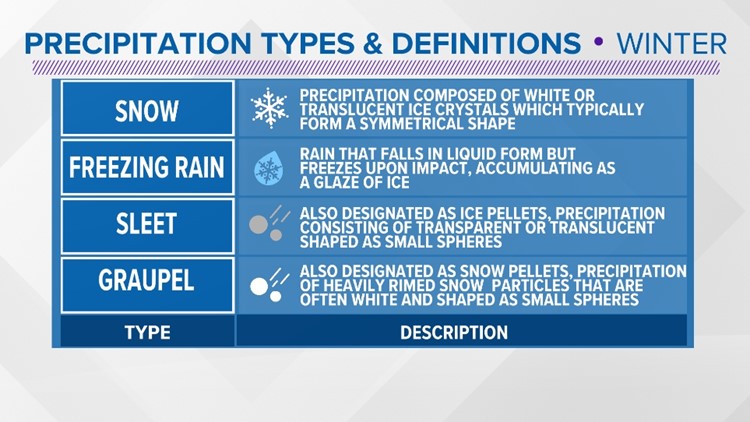BUFFALO, N.Y. — While the most prominent type of winter precipitation for the region is snow, there are a few others that could fall from a winter storm when conditions are right.
Below is a breakdown of a few kinds of winter precipitation that Western New Yorkers are most likely to see each winter.
Snow: This precipitation is composed of white or translucent ice crystals, which typically form a symmetrical shape. In fact, there are up to 35 known shapes of snowflakes!
Freezing rain: This is rain that falls in liquid form but freezes upon impact, allowing this kind of precipitation to accumulate as a glazing of ice. Freezing rain is indistinguishable shape when it falls and reaches the ground because of its liquid state.
Sleet: Also designated as "ice pellets," this precipitation consists of transparent or translucent shaped segments that are usually small and round. Sleet can easily be mistaken for hail, though, as they look very similar and even both have the categorization as ice pellets. However, sleet usually doesn't grow larger than 5 mm in diameter like hail can as hail develops through a completely different cloud process too.
Graupel: Also designated at "snow pellets," this precipitation of is made of heavily rimed snow particles that are usually white and round in nature. These are the photogenic "Dippin' Dots" that can fall from the sky each winter. And while they look like tiny hailstones, they definitely are not.
And since the classifications and look of both sleet and graupel are so similar, here are two ways to tell them apart:
1. Color: Sleet is usually more "see through," or looks like ice, where graupel is usually completely white like snow.
2. Texture: Graupel tends to be softer and more delicate, i.e. you could crush one between your fingers. Sleet will either melt faster in your hand or be harder to crush.
The above descriptions are based on definitions from the AMS Glossary of Meteorology.



